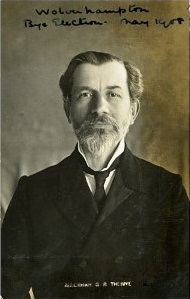George Thorne (politician) facts for kids
Quick facts for kids
George Rennie Thorne, MP
|
|
|---|---|
 |
|
| Born | 12 October 1853 Longside, Aberdeenshire, Scotland
|
| Died | 20 February 1934 (aged 80) Wolverhampton, Staffordshire, England
|
| Nationality | British |
| Occupation | Solicitor |
| Known for | Member of Parliament, Mayor of Wolverhampton |
George Rennie Thorne (born October 12, 1853 – died February 20, 1934) was a British solicitor (a type of lawyer) and a Liberal politician. He was known for serving as the Mayor of Wolverhampton and later as a Member of Parliament.
Contents
Early Life and Education
George Rennie Thorne was born in Longside, Scotland. He went to school at Tettenhall College in Wolverhampton, England. In 1876, he became a solicitor, which is a lawyer who helps people with legal matters.
In 1886, George Thorne married Susan Mary Jones. They had two daughters together. He later became the main partner in a law firm called G R Thorne & Sons, which had offices in Wolverhampton and London.
Local Government Role
George Thorne was very active in the local government of Wolverhampton. He served as a Borough Councillor for many years. Later, he became an Alderman, which was a senior member of the local council.
From 1902 to 1903, he held the important position of Mayor of Wolverhampton. He represented the Liberal party during his time as Mayor. He also led the South Staffordshire Joint Smallpox Hospital from when it first started. Thorne also worked as a Justice of the Peace, helping to keep law and order in the community.
Becoming a Member of Parliament
Before 1908, George Thorne tried to become a Member of Parliament (MP) twice but didn't win. He ran in different areas of Wolverhampton.
In 1908, a special election called a by-election was held in Wolverhampton East. The previous MP, Sir Henry Fowler, had been given a special title called a peerage, so he left his seat. George Thorne ran in this by-election on May 5, 1908.
Thorne was a typical Liberal politician of his time. He was a strong Nonconformist, meaning he was a Protestant who was not part of the Church of England. He was a Baptist, and many voters in his area shared his beliefs.
During his election campaign, Thorne supported several key ideas:
- Free Trade: This meant allowing goods to be bought and sold between countries without special taxes.
- Old Age Pensions: He supported a plan to give money to older people.
- Miners' Hours: He wanted to limit the working day for miners to eight hours.
- Women's Suffrage: He believed women should have the right to vote.
- Irish Home Rule: He supported giving Ireland more control over its own government.
- House of Lords Reform: He wanted to change how the House of Lords (part of the UK Parliament) worked.
- Temperance: He was in favour of reducing or stopping the use of alcohol.
- Disestablishment of the Church of England: He supported separating the Church of England from the government.
Thorne won the by-election by a very small margin, only eight votes more than his opponent, Leo Amery, from the Unionist party.
One reason the election was so close was because of the Suffragettes. These were women who fought for the right to vote. At that time, they often opposed Liberal government candidates. They did this even if the candidate, like Thorne, supported women's suffrage. They wanted the government to pass a law for women's votes.
In this election, something unusual happened. A woman named Mrs. Lois Dawson was accidentally listed on the voting register as "Louis Dawson." Even though the polling officer was surprised, she was allowed to vote because her name was on the list. Her vote was counted, though it might have been removed if the election result had been legally challenged.
Time in Parliament
After winning in 1908, George Thorne kept his seat in Parliament in every general election until 1929. In 1929, he announced that he would step down.
In 1919, he was given an important job. He became a joint Chief Whip for the Independent Liberals. A Chief Whip is like a team leader who makes sure all party members vote together. He held this job until 1923. In that same year, he was also the vice-chairman of the Liberal Parliamentary Party.
See also
- List of Liberal Party (UK) MPs

